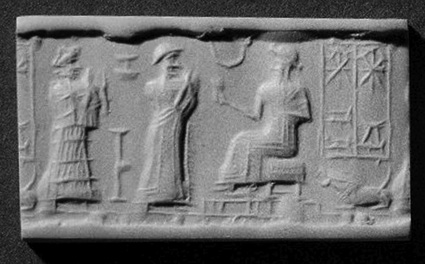Šerida/Aya (goddess)
Goddess of light and wife of Utu/Šamaš, who was worshipped in the cities of Sippar and Larsa.

Impression taken from an Old Babylonian period goethite cylinder seal featuring Aya and Šamaš. The two deities are identifiable by an accompanying inscription. (BM 89030). © The British Museum. View large image on the British Museum's website.
Functions
Aya functions primarily as a goddess of light and as the wife of the sun god Šamaš. Aya's role as Šamaš's wife is exemplified by her presentation in the Standard Babylonian version of the Epic of Gilgameš, where Aya is called "the great bride" (Tablet III, obv. iii 6). In the third tablet of the epic, the hero Gilgameš plans to venture into the Cedar forest and kill Humbaba, its monstrous guardian. Gilgameš's mother Ninsumun blames the sun god Šamaš for her son's desire to go adventuring. She climbs onto the temple roof and asks if Aya will implore her husband Šamaš to protect Gilgameš on his mission, especially at night when the sun god cannot not watch over him. (George 2003: 459-460; (SpTU 4, 124).
In Old Babylonian administrative documents from the vicinity of the city of Sippar, Aya appears also to share her husband Šamaš's role in overseeing justice. Šamaš and Aya are the two deities "witnessing" transactions such as field or house rentals and temple loans (Leichty et al. 1988, e.g., 152, 243).
In the Sumerian literary composition Nanna-Suen's journey to Nibru (ETCSL 1.5.1), Šerida is associated with her cult city of Larsa. She is one of several goddesses who tempt Nanna-Suen (Sin) during his boat journey to Enlil's temple in Nibru. As Nanna-Suen sails past Larsa, Šerida tries to persuade him to deposit the boat's precious cargo there, but he rebuffs her and continues on his way.
Divine genealogy and syncretisms
Aya is the wife of the sun god Šamaš (Utu). In Ugarit, Aya was equated with a deity who shared the same name as her (Galter, 1999). A late recension of the god list An-Anum, Tablet III, from Achaemenid Uruk (c.550-331 BCE) syncretises several other goddesses with Aya (Ninkar, Sudag, Sudgan, Ninmulguna, Munusulšutag) (SpTU 1, 126+).
Cult place(s)
Aya was worshipped with the sun god Šamaš at his two principal temples in the cities of Sippar [~/images/Sippar.jpg] and Larsa [~/images/Larsa.jpg], which were both called E-babbar "white house").
Time periods attested
The cult of Šerida is attested in the early dynastic and Old Babylonian periods (Krebernik 2009-10). Šerida appears in the Sumerian literary composition Nanna-Suen's journey to Nibru (ETCSL 1.5.1) dating to the Old Babylonian period (ca. 1800 BCE).
The goddess's Akkadian name, Aya, is found in personal names as early as the Presargonic period (before c.2400 BCE) (Galter 1999). Aya was a particularly popular goddess during the Old Babylonian period (c.2000-1595 BCE). In Old Babylonian Sippar, Aya was a common divine element in the personal names of female slaves who were owned by priestesses (nadītu). (Harris, 1977).
In the first millennium BCE Aya appears in Neo-Assyrian, Achaemenid and Seleucid period scholarly texts, including the Standard Babylonian version of the Epic of Gilgameš (e.g., SpTU 4, 124) plus new year rituals and a ritual to avert portentious evil (namburbû) from Seleucid period Uruk (e.g., SpTU 2, 018 and TCL 6, 40). Aya became particularly popular again during the Neo-Babylonian Period, during which time king Nabonidus of Babylon from 556-539 BCE, restored Šamaš's E-babbar temple in Sippar (Beaulieu 1989).
Iconography
Aya appears on Old Babylonian cylinder seals with Šamaš, with both deities identifiable from accompanying inscriptions.
Name and Spellings
In the Akkadian language, this goddess's name is Aya whilst in the Sumerian language she is known as Šerida (see Krebernik 2009-10 for Šerida).
- Written forms:
- da-a; dšè-ri5-da, dšè-NIR-da
- Normalised forms:
- Aya, Ayya; Šerida, Šerda, Šer(i)da
Aya in online corpora
- The Cuneiform Digital Library Initiative
- Corpus of Ancient Mesopotamian Scholarship
- Electronic Text Corpus of Sumerian Literature
Šerida in online corpora
References and further reading
- Beaulieu 1989, The Reign of Nabonidus.
- Black & Green 1998, Gods, Demons and Symbols.
- Galter 1999, "Aya".
- George 2003 The Babylonian Gilgamesh Epic.
- Harris 1977, "Notes on the Slave Names".
- Krebernik 2009-10, "Šer(i)da".
- Leichty, Finkelstein, & Walker 1988, Tablets from Sippar 3.
Ruth Horry
Ruth Horry, 'Šerida/Aya (goddess)', Ancient Mesopotamian Gods and Goddesses, Oracc and the UK Higher Education Academy, 2019 [http://oracc.museum.upenn.edu/amgg/listofdeities/aya/]